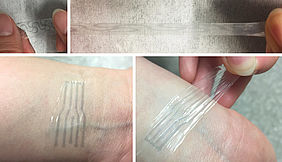Scientists are learning to create smart materials with desirable properties like conductivity, flexibility, bio-compatibility and so on. This makes possible their application in areas that were out of touch in the past.
A particular challenging area is the one of symbiotic relation between a living being and an articraft. Living beings keep changing whilst artifacts tend to stay the same and this leads to compatibility problem. Changes may happen over short period of time; as an example our brain changes its volume and shape during the day. As response to our activity it may swell or shrink. Changes are limited within the skull confines but still they can be significant and, as an example, electrodes that have been implanted in a specific place in the brain may become displaced and no longer be usable.
With this in mind, researchers at Stanford University have created a stretchable material that is bio-compatible and that can match the changes in shape of the brain, keeping its location-relation fixed.
The material is a stretchable polymer that can embed conductive elements, stretchable as well. These can serve as electrodes to sense the local neurones electrical activity and can stimulate them with electric spikes.
The construction of the polymer required the merging of two different molecules, each one balancing the other in terms of properties to achieve the desired characteristics of conductivity and stretchability. Notice that it is not about "mixing" two different substances, rather it is creating a structure composed by two different components. It is more like building a house where you need to place flooring, roof and walls at the appropriate places than to make concrete by pouring together different components.
It is this capability to create smarter material working at molecular level that is of particular interest to me. Besides, in this case, it is interesting to see that materials supporting human-articraft symbioses are becoming available, and even more important, can be designed to fit specific needs.
This provides the technology underpinning to the IEEE Symbiotic Autonomous Systems Initiative.







